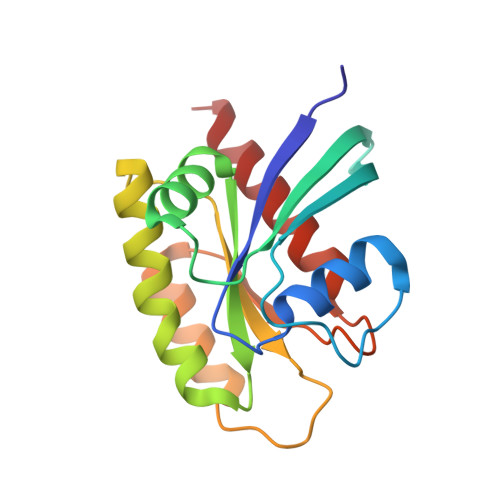In situ selectivity profiling and crystal structure of SML-8-73-1, an active site inhibitor of oncogenic K-Ras G12C.
Hunter, J.C., Gurbani, D., Ficarro, S.B., Carrasco, M.A., Lim, S.M., Choi, H.G., Xie, T., Marto, J.A., Chen, Z., Gray, N.S., Westover, K.D.(2014) Proc Natl Acad Sci U S A 111: 8895-8900
- PubMed: 24889603
- DOI: https://doi.org/10.1073/pnas.1404639111
- Primary Citation of Related Structures:
4LDJ, 4NMM, 4OBE - PubMed Abstract:
Directly targeting oncogenic V-Ki-ras2 Kirsten rat sarcoma viral oncogene homolog (K-Ras) with small-molecule inhibitors has historically been considered prohibitively challenging. Recent reports of compounds that bind directly to the K-Ras G12C mutant suggest avenues to overcome key obstacles that stand in the way of developing such compounds. We aim to target the guanine nucleotide (GN)-binding pocket because the natural contents of this pocket dictate the signaling state of K-Ras. Here, we characterize the irreversible inhibitor SML-8-73-1 (SML), which targets the GN-binding pocket of K-Ras G12C. We report a high-resolution X-ray crystal structure of G12C K-Ras bound to SML, revealing that the compound binds in a manner similar to GDP, forming a covalent linkage with Cys-12. The resulting conformation renders K-Ras in the open, inactive conformation, which is not predicted to associate productively with or activate downstream effectors. Conservation analysis of the Ras family GN-binding pocket reveals variability in the side chains surrounding the active site and adjacent regions, especially in the switch I region. This variability may enable building specificity into new iterations of Ras and other GTPase inhibitors. High-resolution in situ chemical proteomic profiling of SML confirms that SML effectively discriminates between K-Ras G12C and other cellular GTP-binding proteins. A biochemical assay provides additional evidence that SML is able to compete with millimolar concentrations of GTP and GDP for the GN-binding site.
- Departments of Biochemistry and Radiation Oncology and.
Organizational Affiliation:


















